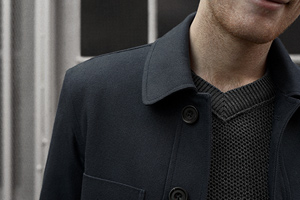July — September 2017
The two-ply worsted of the new SB jacket and trouser is woven by an old mill in Somerset, using the most finely spun worsted yarn. It has all the attributes of linen with none of the drawbacks. It is also, charmingly, a replica of the same cloth the mill once wove back in the 1920s. They evidently had things good back then.

Truth be told, much of the time between, say, April and July — just when the release of new spring-time garments hits full stride — is often too warm to think about knitwear. But someone has to. Besides — this is only a three-ply cotton tuck-stitch. It's barely there. Ahem. More plausible is the quality of the crewneck. It is hand-framed in the south-west of the British Isles, by a troupe of knitters who have been doing so for more than a century.

A Sunday best, this, of corduroy and more corduroy. The slate-grey SB3 and standard trousers are made with middleweight cord from Lancashire. Below, meanwhile, can be seen one a granddad shirt — a pleasing shade called "pebble" — and pin-dot proper trousers, both made with linen woven near Belfast in Northern Ireland.


Introducing, here, new Ventile Flyweight. It is very much like good old Ventile cotton — which is to say, a miraculous rainproof — only so light its weight is on the back barely perceptible. Here it is in the form of the balmacaan: all one-piece sleeve, welted through-pockets, and collar so full it's really a wonder you can see any neck at all.
The overshirt, here, whose collar is very much like that of a shirt, but whose shape, proportion, and raglan sleeve steer it into “mid-weight jacket” territory. Here it is beaming with year-round readiness, in slate-grey cotton cord from Lancashire.
Nothing better than knowing all your checks line up — the checks of a fine glen-check linen from Northern Ireland at that. Apart from on the sleeves, of course. That can’t be helped, seeing as the shirt here has an easygoing raglan construction, with those sleeve-pieces cut “on the bias”, and so on trigonometric grounds precluding all and every effort at full check-alignment.


Made with much the same linen as the above-mentioned shirt are the trousers. Same mill, same yarn, but a different pattern — this one, a fine plain-weave, comprised of middling and dark blue. The cut of the trousers is the proper, with its side-tabs, tall back waistband, and durable French seams on both sides of both legs.

The work jacket is here in what's called working linen. It's a linen of middling weight from Northern Ireland, which even new has a slightly faded, worn-in way about it. It is worn here with a three-ply crewneck, over the top of a shirt, with a Kelly collar made with another Northern Ireland linen — a crisp grey, this time.


This crewneck has a saddle shoulder, which is in many ways the best of both worlds — the soft shoulder of a raglan, and the smart angles of an in-set. It has a three-ply body, a tuck-stitch, and a two-ply plain-stitch body. And the cuffs, as can be seen here, are longer than usual: they're intended to be turned back by the wearer.

They don't come much sturdier than the balmacaan in Ventile canvas. It is worn here with a rollneck — made from geelong lambswool and hand-framed in the south-west of the British Isles — and boasts a large Prussian collar complete with collar-latch, deep two-way welt pockets, and a clean and clinical one-piece raglan sleeve.

This here peacoat is a new development, with a clever "split-sleeve", postbox pockets, half cuffs, and a whopping great Ulster collar. It is made with triple-milled worsted overcoating from a mill in Somerset founded some 200 years ago. Its length is a little longer than the norm; you might also dub it a bridge or admiral coat.

The peccary leather gloves are entirely hand-stitched: an undertaking which takes about eight hours — what with all those fingers and thumbs to navigate. Best thought of as the Rolls-Royce of gloving, peccary, but that such venerable stuff — a symbol of true, olden-days luxury — comes from the hide of a small hairy forest hog is an irony not lost, even on the hog.


































